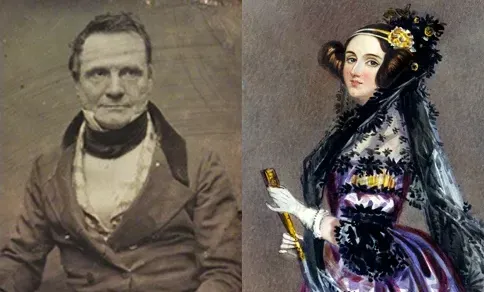Babbage, Lovelace, and The First Computer

Long before Alan Turing revolutionized the field of computation, there was Charles Babbage and his difference engine. Babbage was a man of many skills, most notably in machinery and in economics, even briefly attempting to begin a political career. He grew frustrated with many of the practices used in England during his work in the early 1800’s. His career was filled with his various attempts at reform, some more successful than others. The field he had the most impact on was not realized until well after his death: computation.
At the time, mathematicians relied heavily on tables full of mathematical values, such as logarithms and trigonometric values. These sheets were calculated by hand and took immense effort to create, often riddled with mistakes. Major improvements had recently been made to this process, reducing the operations performed by the human computers to basic addition and subtraction with clever math. Babbage was inspired to automate this process, since these basic operations should be easier to replicate with a machine.
This was a monumental task at the time. Automation was still in its infancy and relied entirely on mechanical, not electrical, processes. In 1822, he worked to create a smaller version of his difference engine. This machine could compute the value of polynomial functions, but only very basic ones. It was important that his calculated only used basic addition and subtraction. This was accomplished using a method called Divided Differences, a long, but ultimately simple, algorithm.
He made several attempts to build the entire machine, excited by the success of his prototype. Unfortunately, he failed every time due to issues either with funding or personal conflict. Only in 2002 was his original design constructed, shown below.
With each attempt, Babbage added improvements to the Difference Engine. The most influential change he made was adding punch cards. This allowed for a much more general computer, and was called the Analytical Engine. He was inspired to add these cards based on the work of Joseph Marie Jacquard, a merchant who used them in his automatic loom. The Analytical Engine, had it been built, would have been Turing Complete.
Babbage had immense difficulty getting others to appreciate the significance of his designs. Most were turned off by the production cost, which was rather large given the intricacy of the equipment. He did, however, find one especially interested individual. Daughter of the renowned poet Lord Byron, Ada Lovelace, known as “Lady Lovelace” had an extensive private education as a child. Her mother emphasized mathematics, seeing it as a cure for the “madness” of poetry she saw in her father. Ada quickly took to math and showed significant promise in the field.
The two met through mutual friends, and quickly developed a strong working partnership. Lovelace became infatuated with the Difference Engine that Babbage showed her. She worked extensively to translate and publish material describing the potential of this machine. Her most famous contribution occur in her translation of a piece written by Luigi Menabrea (future prime minister of Italy) about the Difference Engine. Lovelace added an immense amount of notes to her translation, more than triple the length of the original piece. She had immense foresight into the power of computation and even created the first algorithm to generate a Bernoulli Sequence. The famous “Note G” had predictions on the possibility of artificial intelligence, another powerful accomplishment.
Babbage was thrilled with Lovelace’s contributions and called her the “Enchantress of Numbers.” Her publications were well received, even attracting the attention of Michael Faraday. She, unfortunately, died at the age of 33, cutting short a lifetime of future work. They made an odd pair, but the 18 and 45-year-old layed the groundwork for all of modern computation.
There is a lot more to this story that I left out! If you want to read more about Babbage and Lovelace, I recommend you read the *excellent* graphic novel linked here.
Thanks for reading! Leave a comment if you have any thoughts or questions about this article.




